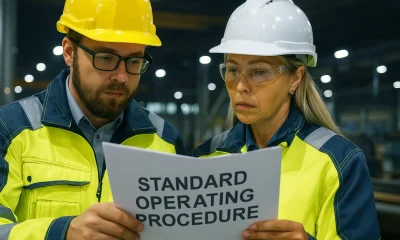UK Drone Regulations
UK Safety Requirements – Drones Regulations
Published
10 months agoon
Table Of Contents

UK Safety requirements when operating drones
Ensuring the safety of drone operations is paramount in the United Kingdom, and the Civil Aviation Authority (CAA) has established comprehensive UK safety requirements that all operators must follow. These requirements are designed to minimize risks, protect people and property, and ensure that drones are used responsibly.
Pre-Flight Checks
Before each flight, operators must conduct thorough pre-flight checks to ensure the drone is in proper working condition and ready for safe operation. Key components of pre-flight checks include:
Battery Levels
- Check Charge: Ensure that all batteries, including those for the drone, controller, and any additional equipment, are fully charged.
- Inspect for Damage: Look for any signs of damage or wear on the batteries, such as swelling or corrosion.
Propellers
- Inspection: Check the propellers for any cracks, chips, or signs of wear. Damaged propellers can lead to instability during flight and increase the risk of accidents.
- Secure Attachment: Ensure that all propellers are securely attached to the drone and that they are properly aligned.
Sensors and Cameras
- Functionality Test: Verify that all sensors (e.g., GPS, obstacle avoidance) and cameras are functioning correctly.
- Clean Lenses: Clean the camera lenses to ensure clear footage and accurate sensor readings.
Firmware and Software
- Update Check: Ensure that the drone’s firmware and control software are up-to-date. Updates often include critical security patches and performance improvements.
- Calibration: Calibrate the drone’s compass and Inertial Measurement Unit (IMU) if necessary to ensure accurate navigation and stable flight.
General Condition
- Frame Inspection: Check the drone’s frame and body for any visible damage or wear. Ensure that the landing gear is intact and secure.
- Connectivity: Test the connection between the drone and the controller to ensure reliable communication throughout the flight.
Flight Log
Maintaining a detailed flight log is an important practice for both recreational and commercial drone operators. A flight log helps track the drone’s usage, monitor its condition over time, and maintain records for compliance and safety purposes. The log should include:
Date and Time
- Record the date and time of each flight.
Location
- Note the location of the flight, including GPS coordinates if possible.
Duration
- Record the start and end times of the flight.
Weather Conditions
- Document the weather conditions during the flight, such as wind speed, temperature, and visibility.
Flight Details
- Flight Plan: Outline the planned flight path and any specific objectives.
- Altitude and Distance: Record the maximum altitude and distance flown.
- Notes and Observations: Include any observations, issues, or incidents encountered during the flight.
Maintenance Records
- Track any maintenance performed on the drone, such as firmware updates, repairs, and component replacements. This helps ensure that the drone is kept in good working condition.
Safety Equipment
Having the right safety equipment on hand is crucial to managing potential risks and ensuring a safe flying experience. Essential safety equipment includes:
First Aid Kit
- Contents: A basic first aid kit should be available to treat minor injuries that may occur during drone operations.
- Accessibility: Ensure the first aid kit is easily accessible during drone operations.
Fire Extinguisher
- Type: A small, portable fire extinguisher suitable for electrical and lithium battery fires is recommended.
- Location: Keep the fire extinguisher within reach, especially when charging batteries or flying in areas with flammable materials.
Protective Gear
- Gloves: Use gloves when handling batteries, sharp components, or hazardous materials.
- Safety Glasses: Wear safety glasses to protect your eyes from debris or chemicals.
Spare Parts and Tools
- Spare Propellers: Keep extra propellers on hand to replace damaged ones quickly.
- Basic Tools: A set of basic tools, including screwdrivers and pliers, should be available for making minor repairs or adjustments.
Emergency Procedures
Being prepared for emergencies is essential for safe drone operations. Operators should establish clear emergency procedures to handle unexpected situations, such as:
Lost Link
- Return-to-Home (RTH): Ensure the RTH function is set up correctly, with a safe return altitude. This feature automatically guides the drone back to its takeoff point if the connection is lost.
- Manual Control: Be familiar with manual control techniques to regain control if the automatic RTH fails.
Battery Failure
- Low Battery Warning: Set up low battery warnings on the drone’s control system and plan flights to allow sufficient time for a safe return before the battery depletes.
- Emergency Landing: Identify safe locations for emergency landings in case of sudden battery failure.
Weather Changes
- Monitor Conditions: Continuously monitor weather conditions and be prepared to land the drone immediately if conditions worsen.
- Wind Limits: Know the drone’s wind limits and avoid flying in high winds or turbulent weather.
Collision Avoidance
- Obstacle Detection: Use the drone’s obstacle detection systems to prevent collisions with buildings, trees, or other aircraft.
- Safe Distance: Maintain a safe distance from obstacles, people, and other aircraft to avoid accidents.
Summary
Adhering to these UK safety requirements is critical for ensuring safe and responsible drone operations By conducting thorough pre-flight checks, maintaining detailed flight logs, having essential safety equipment on hand, and being prepared for emergencies, drone operators can significantly reduce risks and enhance the safety of their flights. These practices not only protect the operator and the public but also contribute to a safer and more professional drone industry.
To Learn more about acronyms used in this article visit our Drones Acronym Page.
Pros
Cons
You may like


What is DAS (Distributed Acoustic Sensing)?


What is CFI (Certified Flight Instructor) & How Does it Work?


What is CAP (Civil Air Patrol) & How Does it Work?


What is STK (Systems Tool Kit) & How Does it Work?


What is SOP (Standard Operating Procedure)?


What is RTN (Real-Time Network) & How Does it Work?